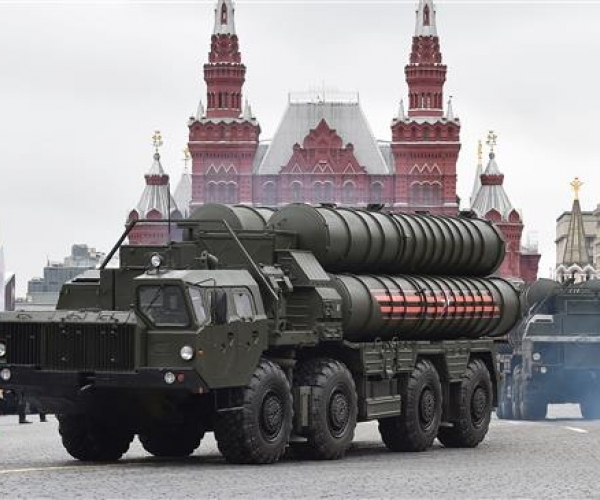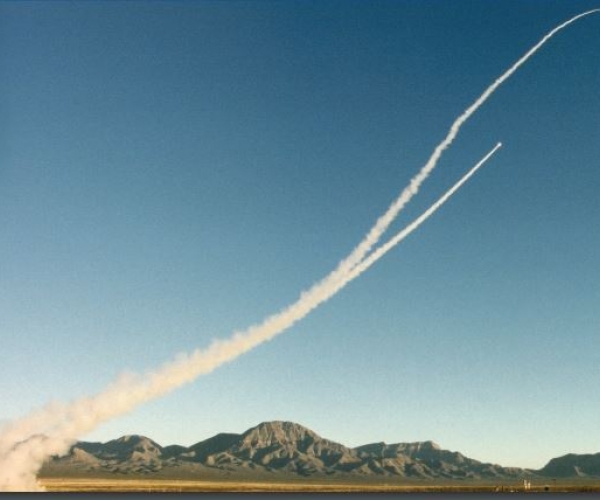Battle of the Air Defense Systems: S-400 Vs Patriot and THAAD

S-400 Triumf air defense system (Image: Russian MoD)
The American-made Patriot and Russian S-400 Triumf air defense systems are currently hogging international orders despite their price tags running into billions of dollars. While the Patriot has more or less a captive market within United States allies, the S-400 has had to sell on its capabilities alone having won orders from Turkey and China, countries which compete with Russia in the international arms market.
Further orders for the S-400 is likely to come from India which has internally approved the acquisition with only a formal signature on the contract awaited to set the procurement process in motion. In addition, Saudi Arabia, Morocco and Iraq are said to be in negotiations to buy the system.
Another US-made system, the THAAD (Terminal High Altitude Area Defense) missile defense system that is designed to intercept ballistic missiles at high altitude is also a competitor for the S-400 regarding some of its features, though not in terms of direct international sales.
Defenseworld.net takes a look at the features of all three systems to determine relative advancement and suitability for various missions.
Quantitative analysis of the three missile defense systems:
|
Characteristics |
S-400 |
PAC-3 |
THAAD |
|
Max. target speed |
4.8 kilometres per second (17,000 km/h; 11,000 mph; Mach 14) |
1.38 kilometers per second (5,000 Km/h; 3106mph; Mach 4.1) |
2.8 kilometers per second (10080 km/h; 6263 mph; Mach 8.24) |
|
Operational Range (km) |
400 km (40N6 missile) |
20, PAC-3 MSE- 35 |
>200 km |
|
Guidance System |
Active Radar Homing |
Inertial/Active millimeter-wave radar terminal homing |
Indium-antimonide imaging infra-redseeker head |
|
Flight Altitude |
185 km for 40N6 30 km for 9M96 and 9M96E2 |
24.2 km |
150 km |
|
Propellant |
YAMZ-8424.10 Diesel V12 |
Single-stage solid |
Pratt and Whitney Solid-fuel rocket |
|
Warhead |
directed explosion warhead |
proximity fused warhead |
No Warheads |
|
Launchers |
At least eight launchers with 32 missiles and a mobile command post |
eight-round |
Consists of at least six launcher vehicles, each equipped with eight missiles, with two mobile tactical operation centers and a ground based radar |
|
Warhead Weight (kg) |
24 to 180 |
90 |
NA |
Data compiled from manufacturers’ websites and other open sources.

S-400 vs. Patriot PAC-3
According to the table above, the S-400 comes across as the most advanced serially produced air defense missile system in the world. Its closest rival is American Patriot with both systems capable of shooting down both aircraft and ballistic missiles. Here is a comparison of technical parameters:
S-400 can shoot down targets moving at a speed of 17 km/hour. (while Patriot/PAC-3 could only shoot down a target moving at 8 km/hour)
S-400 can engage with 72 targets simultaneously and track 160 targets at the. Same parameters for Patriot are 36 and 125 targets
S-400 locates a target at 600 km distance and can destroy at 400 km range (with the latest 40N6E missile that just has been successfully tested). Patriot can locate a plane at 180 km and an enemy’s missile at 100 km
S-400 is able to down targets flying as low as 10 meters and as high as 30 km while Patriot PAC-3 destroys its lowest target at a height of 50 meters with the highest at 25 km
The deployment time for S-400 and Patriot PAC-3is 5 minutes and 25minutes respectively.
Various informed sources have said that to hit an aircraft with a probability not less than 0.99, one will have to launch 1-2 S-400 missiles or 2-3 Patriot missiles. In case of fighting off a ballistic missile attack the ratio will be 1 / 2 or 3 in favor of S-400.
The Patriot system's usage during actual deployment situations has left room for doubt over its performance. For example, after the 1991 Gulf War it was revealed that only a per centage of Iraqi SCUD missiles were actually shot down by Patriot batteries guarding Saudi Arabia and Israel. In case of the Iraqi missile strike against the American military barracks in Dhahran (Saudi Arabia) in February 1991 the failure of the Patriot intercept left to a tragedy – 27 troops were killed, about 100 wounded. In 2003, also the overall performance was better; there were also cases of failed intercepts of the outdated ballistic missiles launched by Saddam’s army in the first days of the invasion. The effectiveness of Patriot systems proved to be low despite almost ideal conditions: low-speed targets, solitary launches, absence of ECM environment and false targets. After 1991 and 2003 significant upgrades are reported to be made but the Saudi experience of countering the Yemeni missiles (comparable to the ones used by the Iraqis) shows almost the same lack of efficiency – see November 2017 missile attack against Riyadh.
Combat use of the Patriot systems has also highlighted some shortcomings of the system: high sensitivity to sand ingestion and unstable electric supply. There have also been reports of accidental launches.
However, the S-400 is yet to be tested in battle so there is no record of it having been fired during actual combat. The system has been deployed in Syria, but didn’t engage any targets yet. There have been reports that the S-400 deployment effectively converted the Russian operating zone over Syria into a ‘No-fly-zone.’ Some western media reports that US-led coalition and Israeli aircraft avoid the area covered by the S-400.
It is interesting to note that China which has its own anti-aircraft and anti-missile air deference system, choose to buy the S-400. It must be remembered that Turkey had first selected then rejected a Chinese proposal for an air defense system.
Increasing US aircraft activity in the South China Sea is believed to have forced China to buy the S-400 from Russia; in the process acknowledging that its own home-grown air defense system were not sufficient to counter sophisticated US aircraft such as the F-35 and F-22. China, which is the first international customer to receive the S-400 is scheduled to test fire the system in August or September 2018.
An ace up the sleeve of the4 S-400 is said to be its ability to detect stealth aircraft such as the F-35 and Chinese J-20 which are characterized by a low radar signature. Exact how effective is this stealth objects detection capability is not known. But suffice to say there is genuine concern among western commentators that the S-400 could covert the F-35 which took some US$396 billion to develop, into a regular 4th generation aircraft effectively negating its tech and price advantage. The same would apply to the Chinese J-20 if the S-400 were to be purchased by India.

S-400 & THAAD
The US-built THAAD is an effective missile defense system whose capabilities of downing ballistic missiles in terms of intercept altitudes and ranges surpass its the rivals. However it is strictly an anti-missile system, which can hit targets only at very high altitudes (minimum 40-50 km) which makes it useless against fighter jets or long range strategic aircraft. It is not an air defense missile like S-400 or Patriot.
“Countries seeking effective defense against aircraft andmissiles will have to buy two costly American systems – Patriot and THAAD, while the Russian S-400 can unite their functions. S-400 can also hit difficult ballistic targets at distances up to 60 km, The ability to shoot down the high-speed targets of S-400 almost equals THAAD (around 17 km/hour),” a defense industry source said.









